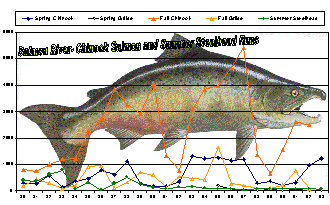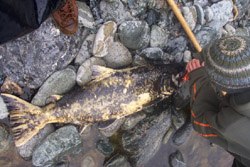The Salmon Riverís Fishery Update
The
Status of the Stocks:
Nat Pennington,
SRRC Fisheries Monitoring Coordinator
Everyone wants to see
thousands of Salmon and Steelhead make the long journey from the ocean back
to the Salmon River to Spawn. For some, fish are a way of life, for others a
reminder of natureís mysteries. Ideally I think most folks on the river
would just like to be able to go fishing and continue a local tradition
thousands of years old. Historical data from the Salmon River late 18-1900s
suggests that there may have been upwards of 30,000 Chinook Salmon returning
each year. Intensive fisheries surveys (chart shown below) performed over
the last 20 years reveal the current plight of our fish stocks. Summer
Steelhead stocks in the Salmon have been critically low over the last
several years. Only 64 summers swam above forks last year to spawn. These
fish receive little or no attention from the managing agencies so itís up to
us to keep them from becoming a part of history.
 The Salmon River Restoration
Council is in the middle of the Winter Steelhead survey season and is
gearing up for next years Spring Chinook projects. Some of the current
projects between SRRC and cooperators for Spring Chinook restoration
include, radio tracking of adults, otilith analysis of springers and falls
for better harvest practices, and fish disease mortality assessments. With
the help of our trained community fish crew and local Salmon River fish
gurus these projects may go a long way in identifying the problems related
to restoring Salmon River fish stocks.
The Salmon River Restoration
Council is in the middle of the Winter Steelhead survey season and is
gearing up for next years Spring Chinook projects. Some of the current
projects between SRRC and cooperators for Spring Chinook restoration
include, radio tracking of adults, otilith analysis of springers and falls
for better harvest practices, and fish disease mortality assessments. With
the help of our trained community fish crew and local Salmon River fish
gurus these projects may go a long way in identifying the problems related
to restoring Salmon River fish stocks.
The results of radio tracking springers in the salmon last year may shed some light on problems in the basin. Of the three tagged springers that entered the Salmon, one went missing, one died from gill rot, and the last tag was found on a river bar, minus the fish which was either poached or caught by an animal.
Disease and mortality
assessments of Spring Chinook are uncovering one of the big culprits for
declining returns in the basin. Analysis of springer carcasses in the South
Fork Salmon revealed that over half of the fish were infected with
Columnaris (gill rot). Thirty-two unspawned dead salmon were found during
the annual cooperative fish dives and by the local fish monitoring team. It
is likely that many of these died from diseases present in the Klamath that
spread as fish head upstream.
The Karuk Tribe, SRRC and the
US Fish and Wildlife Service are cooperating on a research project involving
Chinook ear bones (otiliths), sounds kinda strange huh? Amazingly enough if
you look at enough ear bones from one watershed you can tell them apart from
any other ear bone in the system. This info can be used to identify where
and when springers are being harvested down river and in the ocean. The data
may enable several fishing interests which have expressed the desire, to
selectively harvest and avoid wild stocks especially
SRRC employees check Spring Salmon for
disease
Salmon River Spring
Chinook.
The SRRC has been funded to coordinate and assist restoration and monitoring projects relating to all anadromous fish in the basin. We will be hiring crews to perform fish surveys throughout the year. Anyone interested in helping with projects or learning more about Salmon River fish restoration and monitoring can contact me at the SRRC office (530-462-4665) or visit our web page (srrc.org).